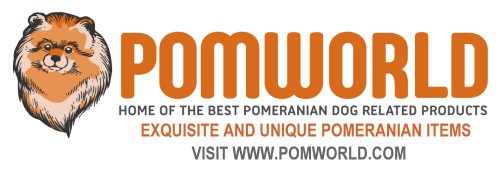Last Updated on 29/11/2023 by Dochlaggie. Post first published on November 16, 2022.
Welcome to Pomeranian crate training, I am going to share my knowledge obtained over many decades to help you quickly and easily crate train your Pomeranian. For correct and easy Pomeranian dog crate training the only requirements are a Pomeranian cage, your Pomeranian, a little patience, and commonsense.
I will show you that crate training Pomeranian puppies and even adult dogs are easy and quick to achieve. To train your Pomeranian properly, you need a number of tools. One of the best tools is a crate or dog cage for Pomeranians. This may be a conventional carrier or a wire fold-up crate, or even an xPen.
Crates are terrific for potty training Pomeranians and will save you tons of money when it comes to potential damage to furniture, floorings, and other items in your home.
Because a dog crate is portable, you can take it with you if you go on trips and wish to take your beloved pet with you. It increases the safety factor when your Pom is actually traveling, regardless of the mode of transport.
Because he’s used to his dog crate, he’ll be more comfortable on trips, and never underestimate the comfort level of your pet. It can make a huge difference to your vacations and days out.
People involved in raising, essential Pomeranian training, and showing dogs will already appreciate the full list of benefits that a dog crate provides. However, a new owner may not have this particular essential piece of information.
“Canis familiaris,” the domestic dog, is descended from “Canis lupus,” the wolf. In the wolf den, the mother wolf cleans up the cub’s feces until the youngsters are old enough to defecate away from the den. The cubs learn that the den is a place to keep clean as well as a place of safety and comfort.
A modern den can be an xPen or a Pomeranian cage that can be kept in any room in the house. The dog crate is a multi-purpose piece of dog paraphernalia.
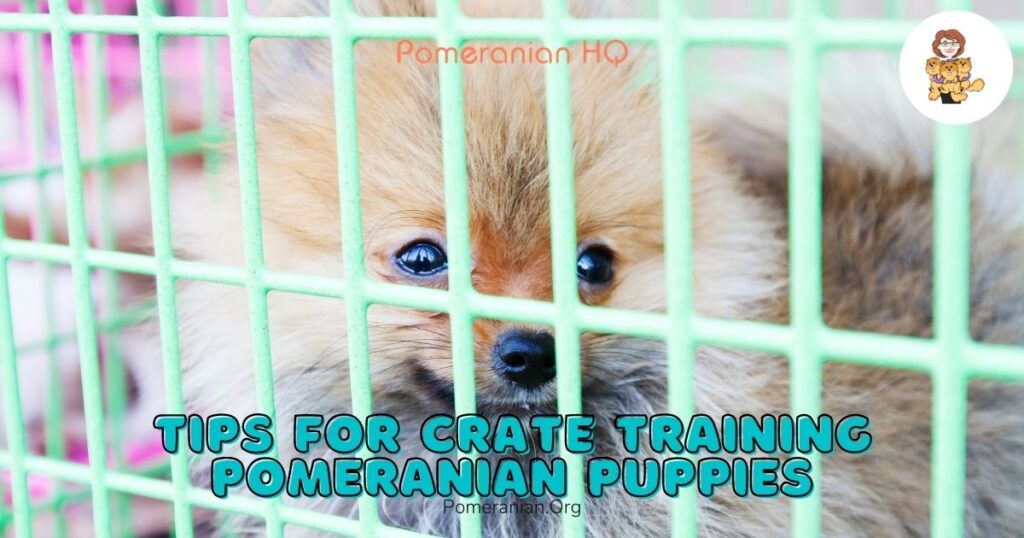
Why Pomeranian Puppy Owners Require a Pomeranian Crate
Pomeranian Potty Training
A dog crate for Pomeranian or xPen is a valuable Pomeranian potty training tool for puppies and will help with house training adult dogs.
Use a Playpen for Pomeranians When You’re Not Home
If you need to take the kids to school or go to the grocery store, the pup that’s crated will not chew the furniture or wet the carpet while you’re gone. If he has already wet the carpet or chewing the furniture, you can put him in the crate and issue a stern warning that there’ll be no more of that going on.
A Sanctuary for the Over-Excited Pomeranian Puppy
Don’t let Fluffy run amok through the house, terrorizing the cat, the kids, and the furniture, and don’t feel guilty about restricting his freedom. Sending the pup to his crate is somewhat akin to sending a child to his room: he feels comfortable there and he knows you are angry, and you have a chance to recover from his outburst.
After the pup has finished house training, leave the crate open during the day. You’ll find that the pup will nap in the dog crate by choice. You can continue to put the pup in the crate when you’ll be away from the house as long as you don’t leave puppies and young dogs confined too long and make sure they have plenty of exercise when you are home.
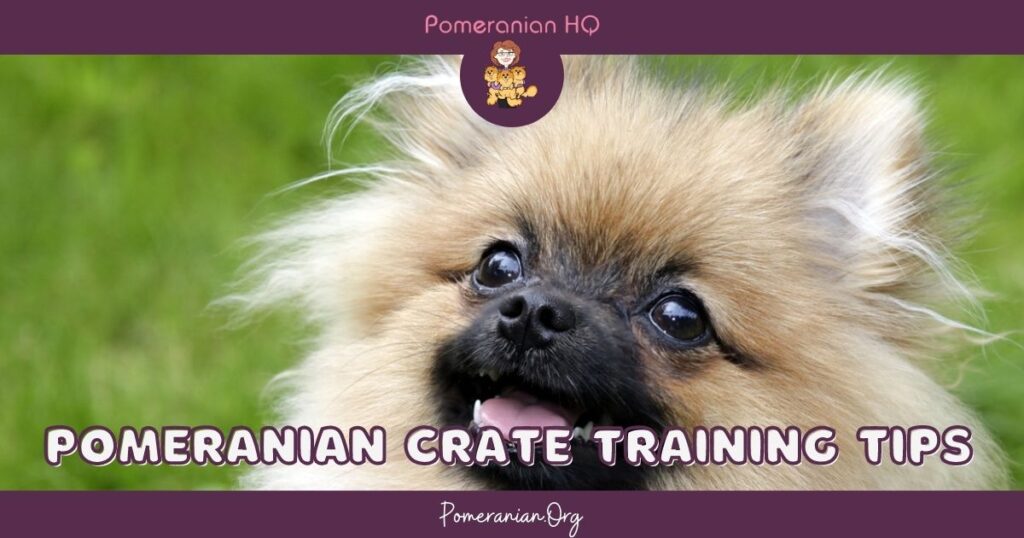
Tips for Successfully Dog Crate Training Pomeranians:
- Buy the correct-sized Pom puppy crate for house training. What size crate for a Pomeranian is best? The dog crate must be big enough for an adult Pomeranian to stand, turn around, and sit or lie down without any hindrance.
- Set your puppy’s crate up in the bedroom. This is because he’ll want to have an association with you when you’re also in bed.
- Place a few treats inside and around his crate to help introduce him to it. Feed him a few times in his dog crate so he associates food with his new home as well.
- Take off tags, a collar, and/or a lead whenever he’s in his crate so he can’t get tangled up or try to chew them and choke.
- Well before bedtime, put the puppy in his dog crate and give him a treat. Then shut and lock the crate.
- Leave the bedroom but stay just outside and listen to see what he does.
- If he starts to make any sounds (separation responses) such as growling or barking, raise your voice and tell him to be quiet. If this doesn’t make him stop, rattle a shaker can (with small stones or coins inside) or whack a newspaper against the door as it will make a loud noise.
- It may take anywhere from three to eight attempts to attract your attention before your puppy finally settles down. Once he’s quiet, don’t let him out for 10 minutes.
- When you do bring him out, don’t praise or pet him immediately or his desire to be let out of the dog crate may become stronger.
- After 30-45 minutes, you can go through the whole process again. Make his quiet time about 30 minutes.
- Allow him to have one toy when he’s in the dog crate. Once his real bedtime arrives, he’ll already associate being quiet with time in his dog crate.
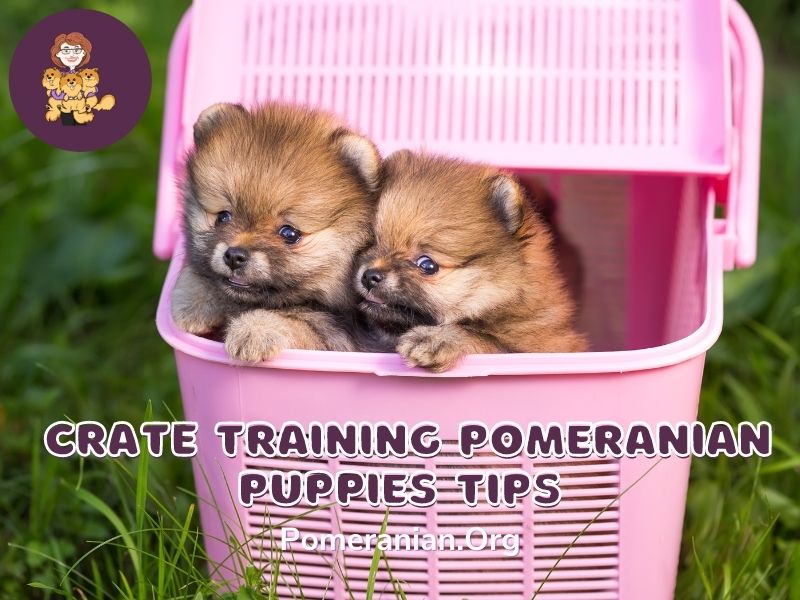
Reduce Separation Anxiety with Pomeranian Training
Separation anxiety will be reduced because you have put the dog crate in the bedroom so even when he wakes, he’s feeling safe because of your presence. Isolation/separation is the harshest punishment for any puppy so it’s a last-resort option when you have tried everything else and failed.
The puppy will generally eliminate as soon as he wakes up. He’ll no doubt make noise (barking or whining) because dogs dislike eliminating where they sleep. To successfully achieve potty training take him outside to eliminate as fast as you can.
Pomeranian Puppy can then be taken outside to eliminate because this has a few advantages:
- Your puppy doesn’t develop the bad habit of eliminating inside.
- If he can’t be supervised during the day, he can be placed in his crate or a day pen that’s located in a central room in your home.
- Separation anxiety is decreased swiftly, preventing potential side effects caused by stress.
- Once your puppy has been properly house-trained, he’ll prefer to spend time in the “den” if you can’t supervise him through the day. As he matures, he’ll go into his den voluntarily when he wants to have a rest. When you’re training your puppy in his crate, be sensible. He shouldn’t be kept in it for long periods.
How to Crate Train a Pomeranian Puppy
Dog Crate Training a Pomeranian puppy does not have to be difficult. A young puppy must not be confined to a Pomeranian cage for lengthy periods of time. A general timeline is to expect a Pomeranian puppy to be able to hold on for absolutely no more hours than the number of months of their age.
His age in months, and how long he’ll be able to hold on generally, are the same so don’t complain if you keep a one-month-old puppy in his Pomeranian cage for 8 hours and he makes a mess. Work out the best ways to structure your puppy’s life. Then he’ll feel more secure and happy and that makes you happier and strengthens your bond.
Breeders suggest a pen should be four-foot square. It can be a plastic baby’s playpen. Place it in a central room in your home so you can work on daily Pomeranian training.
His toys, bed, and food can be placed in one corner. A litter box, some newspaper, or a pee pad can go in the opposite corner. Ensure the floor under the pen can be cleaned easily. Use a tarpaulin or heavy plastic sheeting.
Put your Pomeranian in his pen whenever you can’t spend time with him and you’ll avoid him having accidents, while simultaneously training him to handle alone time and to use the pee pad.
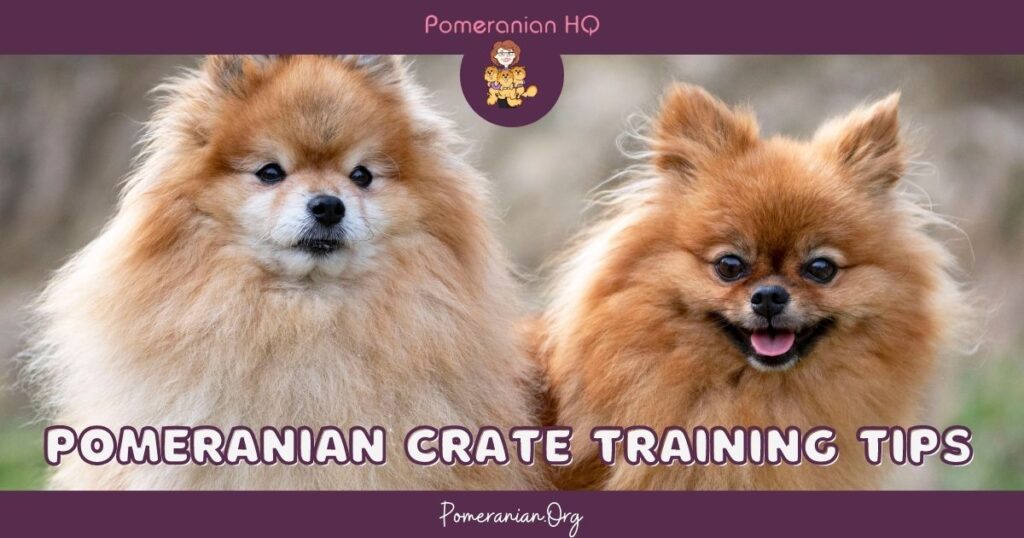
Conclusion: How to Dog Crate Train a Pomeranian Puppy
People often cringe at the thought of putting their beloved Fluffy in a box or cage. They think confinement is cruel. After all, people don’t want to be enclosed in a space they can barely turn around in. But even Pomeranian puppies aren’t people. Their wolf ancestors found comfort, safety, and shelter in their dens, and modern Pomeranians find solace and satisfaction in their own space as well.
Crate training can be an easy way to help potty train your Pomeranian, but you must follow these tips and guidelines.
What owners need to know: Dog crate training requires patience and consistency like any dog breed or pup.
The goal of this process is for your Pom to learn how good things happen when they go into the kennel or their “den.” You want them to understand that going in there means they will get food, water, bedding (or blankets), treats, or whatever they like.
Make full use of the how-to crate train Pomeranian puppy tips to quickly and easily achieve complete Pomeranian potty training and avoid most Pomeranian house training problems.
The process of dog crate training can seem daunting, but with the right approach and consistency, it becomes much more manageable.
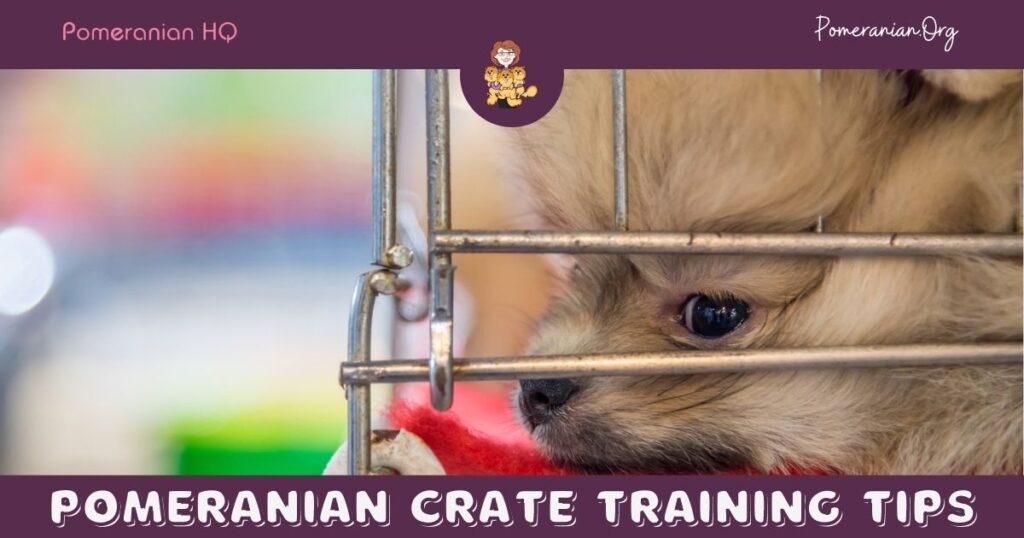
Recommended Best Dog Crates and Pens for Pomeranians
Copyright Pomeranian.org. All Rights Reserved.
References and Further Reading:
[1] Denise Leo “The Pomeranian Handbook”.
[2] Denise Leo “Training Your Pomeranian ”.
Learn More About Pomeranian Dogs in My Book The Pomeranian Handbook
Train your Pomeranian. Top Training Tips and Secrets is available here on THE Pomeranian Information Site as an eBook in PDF format. Download and store on your computer, tablet, phone and print a hard copy if required. Training your Pomeranian is also available at Amazon.Com in Kindle format and other outlets including iBooks, Nook, Kobo, Copia, Gardner Books, etc.


